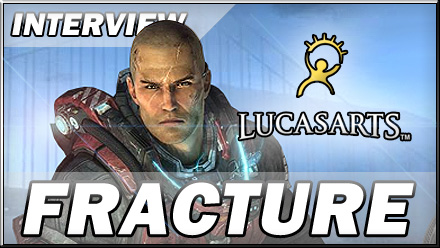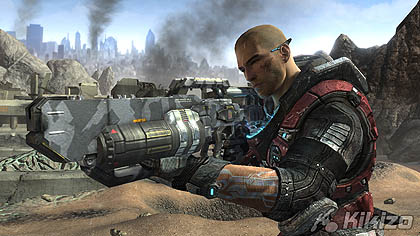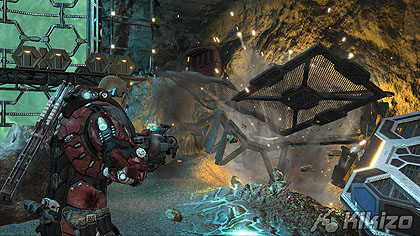Fracture Hands-On & LucasArts Interview
Does LucasArts' new game break new ground - or its promises? We met with the company's Jeffrey Gullett to chat about the project and get some hands-on.

Page: 1 2
These are anxious times at LucasArts. The firm, home to such franchises as Indiana Jones and Star Wars, let go around a hundred of its employees earlier this year. Company reps cited product life cycles as a reason but insisted that the company was still healthy. Among those that successfully avoided this jagged shrapnel was the team responsible for Fracture. I met recently with Jeffrey Gullett, an assistant producer on Fracture at LucasArts, to find out more about the game and to play it myself.
The most immediately notable feature of the game, which is being developed with Day 1 Studios in Chicago, is how focused it is on its core conceit. From the moment the brief demo - which LucasArts will soon be offering to the public - boots up I was aware of terrain deformation and over the next 10 minutes or so the game would try to convince me how indispensable an intimate knowledge of its intricacies would be to success.
The tool behind this unnatural ability is the Entrencher - a weapon that can be used offensively and defensively. Aim the Entrencher at the ground and the earth will literally bulge, providing not only cover from assailants but also a path up to otherwise unreachable territory. It's usable anywhere, offering players freedom and making things trickier for the designers, who had to work that much harder to ensure enemies are aware of the altered landscape at all times.
One of the concerns the team had is whether people would actually play the game the way they intended while not making the experience too guided. "It was one of those things where we didn't know how quickly people were going to catch on to it and all of its potential uses," says Gullett. "Something that we've worked on really diligently right from the beginning was figuring out how to make this mechanic become second nature, so as soon as people get the hang of it and realize how it works that they keep it in mind and realize that this is another weapon in their arsenal to use that they've got to use throughout the entire game."
Having so many ways to play the game opens up all sorts of ways to break the game too, so the team made a point of getting Fracture in front of gamers early. Among the biggest challenges was pathfinding, allowing enemies to be able to be aware of the changes brought to the environment around them. Gullett says that playtesting started very early in the development process and has continued alongside development deep into the process. These tests gave the developers the confidence that they were moving in the right direction and, as is usual in tests of this sort, they brought out behaviour that the team had not anticipated.
"Every time that I've sat and watched somebody play the game, especially people who have never played it before and first pick it up, I always see them do something different, something I've never seen a player do," says Gullett.
Among the tricks observed during playtesting that were added to the game was the offensive use of terrain deformation in confined spaces. One intrepid tester noticed a group of enemies in a small covered area and tried to crush them to death by raising the group into the roof using a Tectonic grenade. The game broke that time but the team followed up on the idea and added the tactic to its repertoire. Then there was the time another tester tried riding the rising column of a Spike grenade. He failed too but his experiment hastened the action's transition into the game.
This movement of ideas from testers to developers was replicated in the movement of ideas from the studio to third-party technology partners. Just like many other developers, Day 1 and LucasArts turned to Havok for a physics engine that would let them get a leg up on development, but the process was more organic than it usually is in other projects. For one, Havok had not built its engine to take into consideration completely malleable ground structures, and when the developers starting raising the earth, out crawled the bugs. This had the result of bringing together engineers from both sides of the partnership who worked to mould the engine around Fracture's needs.
Problems such as these are only going to become more common, says Gullett, as developers think up new ways for players to interact with their virtual worlds and consequently take the guts of modern consoles in directions never envisioned by their makers.
"We're really pushing the limits of what these consoles can do technically," he says. "It takes a lot of processing power to do what we're doing, at the level and extent that we are, and giving the player as much freedom as they want is really intensive on these processors. We're really sort of pushing the limits of what these systems were designed to be able to do. This is something that was never expected to be able to do when a lot of these systems were created."
Page: 1 2











 Satoru Iwata Video Interview - the late Nintendo president spoke with Kikizo in 2004 as 'Nintendo Revolution' loomed.
Satoru Iwata Video Interview - the late Nintendo president spoke with Kikizo in 2004 as 'Nintendo Revolution' loomed. Kaz Hirai Video Interview - the first of Kikizo's interviews with the man who went on to become global head of Sony.
Kaz Hirai Video Interview - the first of Kikizo's interviews with the man who went on to become global head of Sony. Ed Fries Video Interview - one of Xbox's founders discusses an epic journey from Excel to Xbox.
Ed Fries Video Interview - one of Xbox's founders discusses an epic journey from Excel to Xbox. Yu Suzuki, the Kikizo Interview - we spend time with one of gaming's most revered creators.
Yu Suzuki, the Kikizo Interview - we spend time with one of gaming's most revered creators. Tetris - The Making of an Icon: Alexey Pajitnov and Henk Rogers reveal the fascinating story behind Tetris
Tetris - The Making of an Icon: Alexey Pajitnov and Henk Rogers reveal the fascinating story behind Tetris Rare founders, Chris and Tim Stamper - their only interview? Genuinely 'rare' sit down with founders of the legendary studio.
Rare founders, Chris and Tim Stamper - their only interview? Genuinely 'rare' sit down with founders of the legendary studio. The History of First-Person Shooters - a retrospective, from Maze War to Modern Warfare
The History of First-Person Shooters - a retrospective, from Maze War to Modern Warfare